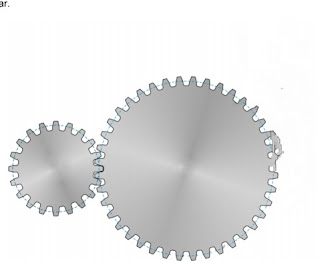 |
| Advantages and Disadvantages of Gear Drives |
Advantages of Gear Drives
1) For transferring high power Gear drives are used.
2) It is defendable in service.
3) Gear drives having efficiency is elevated.
4) In gear drives use centre distance is small for shafts.
5) High Efficiency: Gear drives offer excellent power transmission efficiency, typically ranging from 95% to 98%. They minimize energy losses during transmission, ensuring that the majority of the input power is effectively delivered to the output.
6) Precise Speed Ratio: Gear drives provide accurate and consistent speed ratio between the input and output shafts. This feature is particularly important in applications where precise speed control is required, such as in machine tools and robotics.
7) Gear drive is positive drive so velocity is constant.
8) High Torque Transmission: Gear drives are capable of transmitting high torque loads. They provide reliable and robust power transmission, making them suitable for heavy-duty applications that require substantial torque, such as in industrial machinery and vehicles.
9) Compact Design: Gear drives can achieve high gear reduction ratios in a relatively compact form factor. This allows for space-saving designs, making them suitable for applications with limited space or weight constraints.
10) It is used lubrication so less maintenance is required.
11) In gear drive there is no slip, so exact velocity is acquire.
Disadvantages of Gear Drives
1) When gear drives are in high speed velocity and noise are obtained.
2) Lubrication Requirements: Gear drives need proper lubrication to ensure smooth operation and prevent wear. Lubrication maintenance, such as regular oil changes and monitoring oil levels, is necessary to extend the lifespan of the gears and maintain their performance.
3) For gear drive manufacturing and maintenance cost is high.
4) For manufacturing of gears requires special perticular tools and required skilled labours.
5) This process costlier than other drives.
6) Requires proper alignment between the shafts.
7) It the gear drive there is no flexibility.
8) Maintenance and Wear: Gears are subject to wear and tear over time, especially under high loads or inadequate lubrication conditions. Regular maintenance, including inspection and replacement of worn gears, is necessary to ensure the long-term reliability of the gear drive system.
Applications Of Gear Drives
Gear drives have numerous applications across various
industries and fields. Some common applications of gear drives:
Automotive Industry: Gear drives are widely used in
vehicles for transmitting power and torque. They are found in transmissions,
differentials, and steering systems.
Industrial Machinery: Gear drives are extensively
employed in industrial machinery, including manufacturing equipment, machine
tools, conveyor systems, and robotics. They help in transmitting power,
controlling speed, and providing torque multiplication.
Wind Turbines: Gear drives are crucial components in
wind turbines for converting the low-speed rotation of the turbine blades into
high-speed rotation required by the generator.
Aerospace Industry: Aircraft rely on gear drives for
various applications, such as controlling the movement of control surfaces,
retracting landing gears, and driving auxiliary systems.
Power Plants: Gear drives are used in power plants to
transmit power from turbines to generators. They play a crucial role in
converting rotational motion into electrical energy.
Mining and Construction Equipment: Heavy machinery
used in mining and construction, such as excavators, bulldozers, and cranes,
often employ gear drives for power transmission and torque conversion.
Marine Applications: Gear drives are used in marine
propulsion systems, enabling ships and boats to convert engine power into
rotational motion for propeller operation.
Robotics: Gear drives are essential in robotics for
transmitting power and controlling the movement of robotic arms and joints.
Medical Equipment: Precision gear drives find
applications in medical equipment like imaging systems, robotic surgical
devices, and diagnostic machines.
Printing Machinery: Printing presses and other
printing equipment use gear drives for precise control of paper feeding, ink
distribution, and other mechanical operations.
These are just a few examples of the diverse range of
applications where gear drives are utilized. Their ability to transmit power,
control speed, provide torque multiplication, and offer precision make them
integral components in many mechanical systems.
So in this article we learn the topic Advantages and Disadvantages of Gear Drives hope you understand well.
Any queries regarding this article comments below. Thanks for reading.



.jpg)



